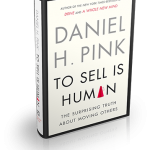What do you think of when you hear the word “sales”? Chances are that you equate it with words like untrustworthy, pushy and slick – all negative descriptors. What if someone were to say that we as educators are also in sales – and in one of the largest sales-driven sectors in North America? Would you agree? What if instead of the word ‘sales’ we substituted the word “move” – that is the idea of moving someone from one point of view/level of knowledge/position to another?
My route to teaching was circuitous, including an MBA and time in the private sector. I now teach a language elective, Japanese, to students in a Canadian high school. Perhaps due to this, I’ve always viewed my students as my ‘customers’. A lot of my colleagues have bristled at the idea but I would argue that the effective teacher of today cannot ignore the need to market his or her program. In the past the school/classroom teacher had a monopoly on delivering education. But these days students have other options open to them. Like customers, they vote with their feet in choosing both courses to take and delivery style (classroom, online etc). So how do I establish, and more importantly, maintain my program? That is, how do I move students to continue to see the value in what I teach for their own lives?
Enter “To Sell is Human” by Daniel H. Pink in which he puts forth the idea that we are almost all involved in selling. For me it is a book that clearly states the challenges/realities of being a successful educator in the 21st century. The book is easily read – meaning that I found it simple to take the examples and cases he offers up, and see similar ones in the education realm. Throughout the book I gained an appreciation for, and confirmation of, what it means to be someone who successfully moves people to a desired endpoint. He stresses that unlike salespeople of the past who had to “Always Be Closing” the successful sales/movement mantra of today is “Attunement, Buoyancy and Clarity”; being attuned to others, have buoyancy to ‘stay afloat’ no matter how rough things may get and provide clarity – skills that are equally key to success in the classroom.
I feel passionately that we as teachers, especially teachers of elective courses, do not spend a lot of time expounding on the value of what we offer. As a marketing student at university I learned the concept of ‘post-purchase cognitive dissonance’ – which is the state of unease which exists in the customer’s mind after buying a product or service. I don’t want my students to ever regret opting for my course. In part that means that I work to connect – to be attuned in providing opportunity and challenges that ring true with them. It also means an increasing amount of time spent having students actually realize what they have accomplished. Using “I can..” statements, taking the time to have them identify their areas of strength, checking in with them helps them to value their progress – and allows me to fine-tune to meet their learning needs. My course, my product, has to remain current and valid in a changing world and information from my customers – while not what drives the course solely – is key. I have to, according to the book, make it personal and purposeful.
The chapter called “Perfect Your Pitch” really struck home. Over the time that I have taught I have come to the realization that my class is really not about languages per se. It is about the qualitative soft skills that the discipline provides. I take time now from my teaching to talk with my students about this and to remind them of what skills – teamwork, incorporating feedback, problem solving, independent learning – they are acquiring along with their ability to communicate in Japanese. I am, to refer to the book, ‘perfecting my pitch’ for why language studies are so important.
“To Sell Is Human” is a unique resource for teachers looking for an explanation of what it means to be a successful mover of people in the 21st century. After all, as the authour puts it, successful salespeople today require “a keen mind, a deft touch and a sense of possibility”. I dare anyone not to use those words describing the most successful teachers that they know.
Colleen



5 Comments
Leave a reply →